How Do Substrates Affect the Friction on Graphene at the Nanoscale?
Abstract
:1. Introduction
2. Methods
3. Results and Discussions
3.1. The Effect of Substrates on the Nanofriction of the Graphene Surface
3.2. The Impact of Substrate on Bonding of the Graphene Surface
3.3. The Effect of Charge Transfer between Gr and the Substrate on the Tribological Property of Gr Surfaces
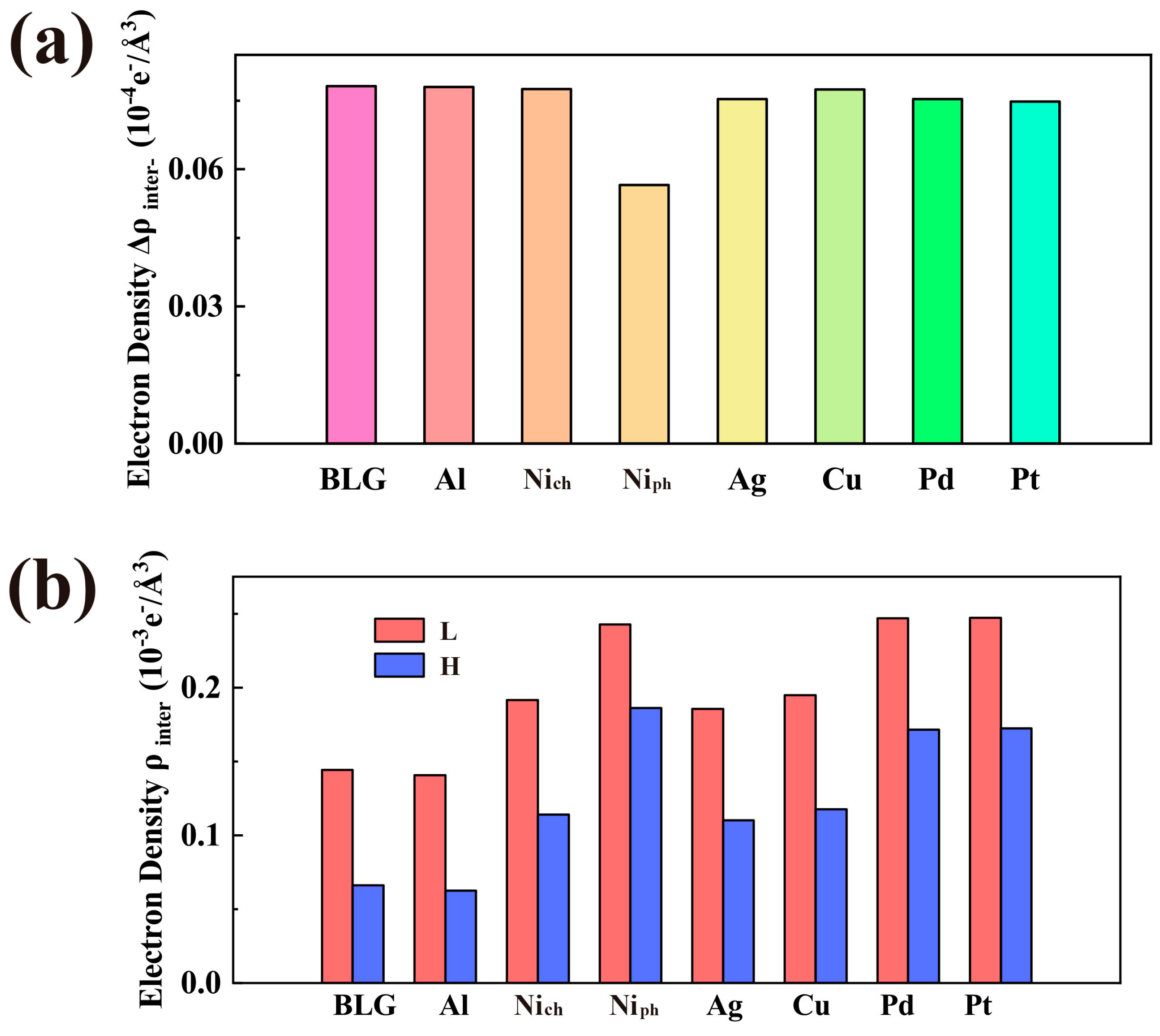
4. Conclusions
Author Contributions
Funding
Data Availability Statement
Conflicts of Interest
Appendix A. The Binding of Gr-Gr/Metal and Tip-Gr/Metal
| Parameter | Substrate Materials | |||||||
|---|---|---|---|---|---|---|---|---|
| Al | Cu | Pd | Pt | Ag | Niph | Nich | None | |
| Distance of adsorption (Å) | 3.45 | 3.14 | 2.34 | 3.3 | 3.34 | 3.32 | 2.04 | / |
| (meV/atom) | 26 | 34 | 64 | 35 | 42 | 55 | 117 | / |
| Lattice constant of graphene after matching (Å) | 2.44 | 2.43 | 2.45 | 2.38 | 2.39 | 2.45 | 2.45 | 2.46 |
Appendix B. The Sliding Path Adopted for Simulations
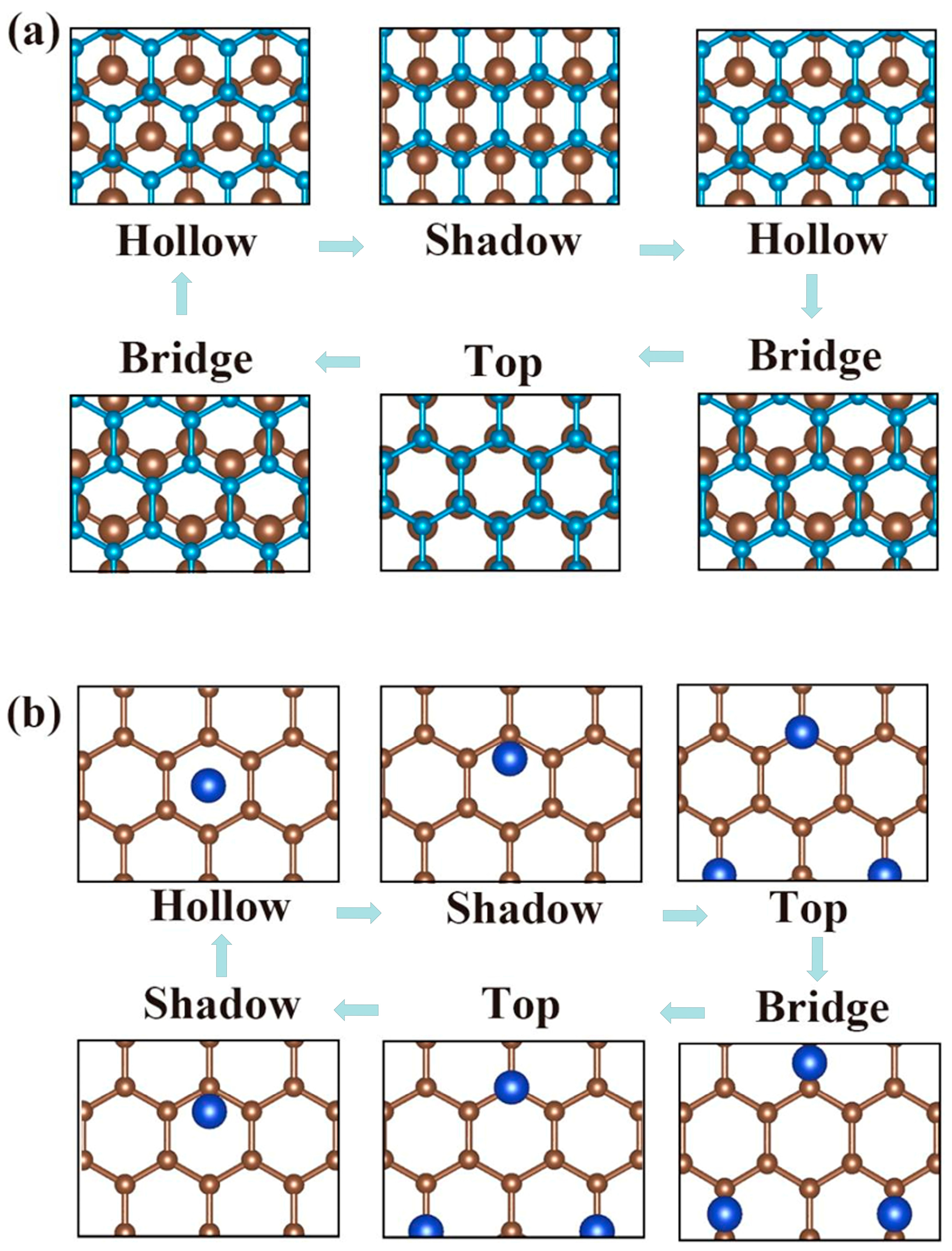
Appendix C. Fluctuations in Energy


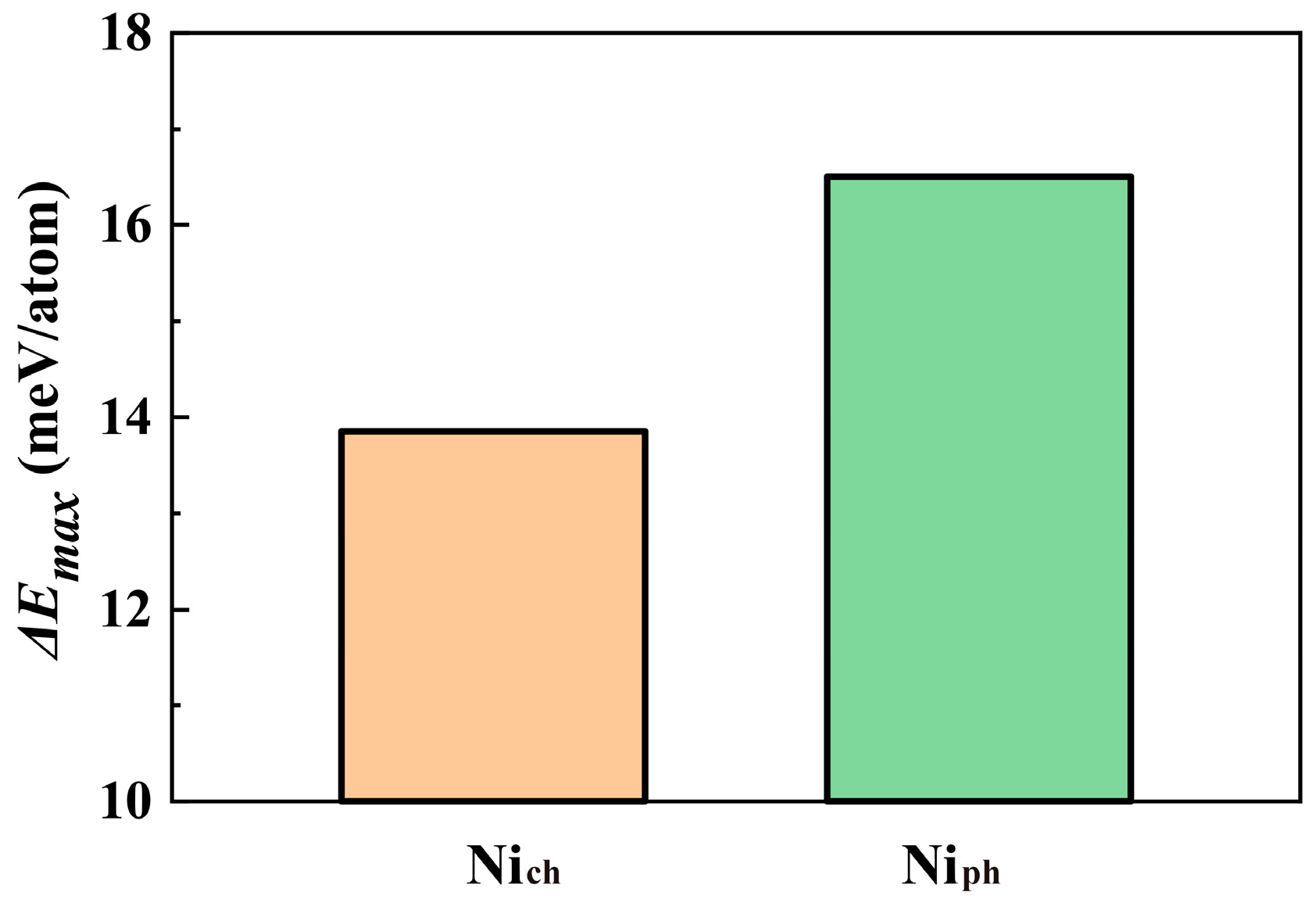
Appendix D. Calculations of Electron Density Difference
Appendix E. Stackings in the Gr-Gr/Metal System

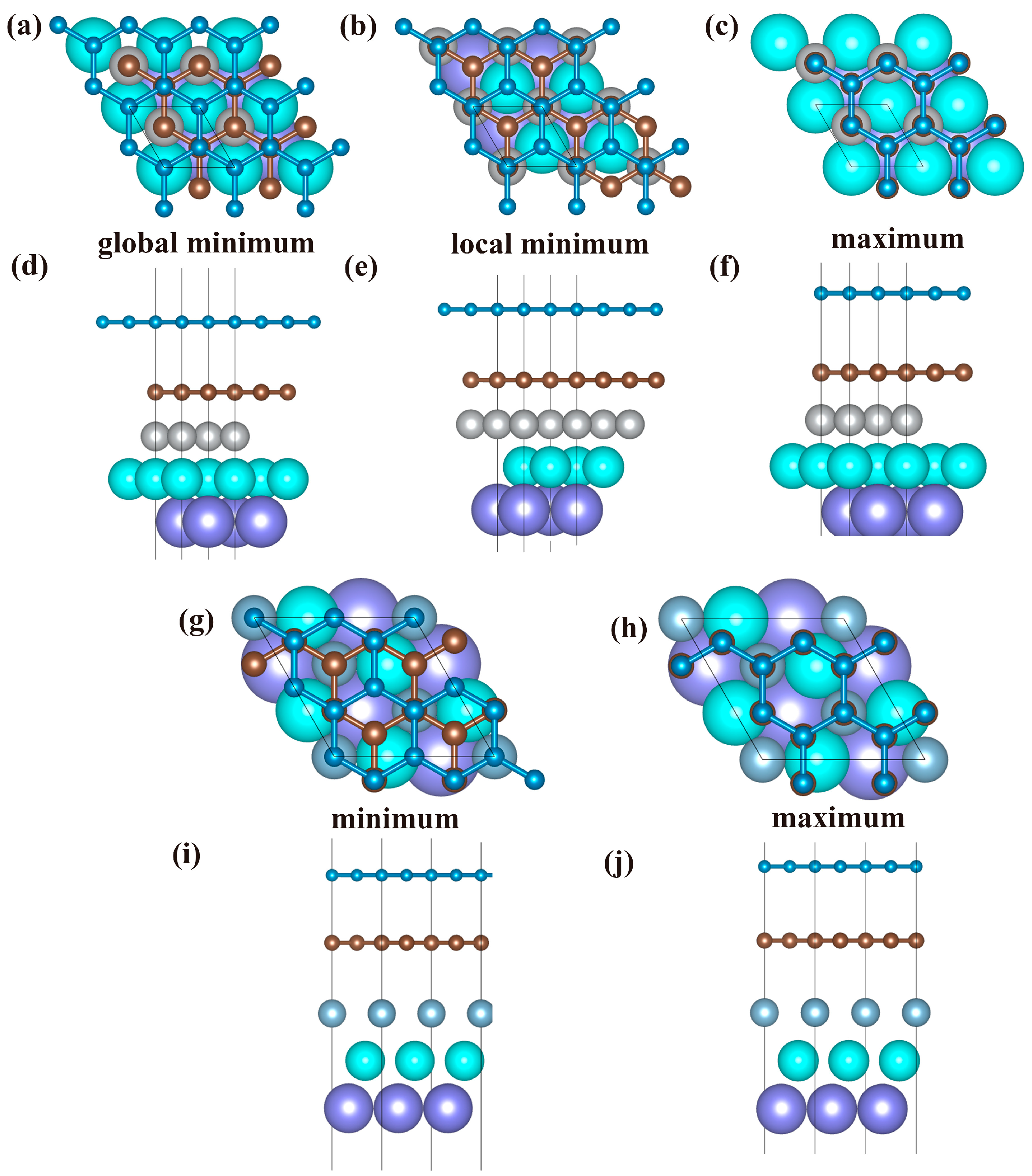
Appendix F. Electron Density Analysis
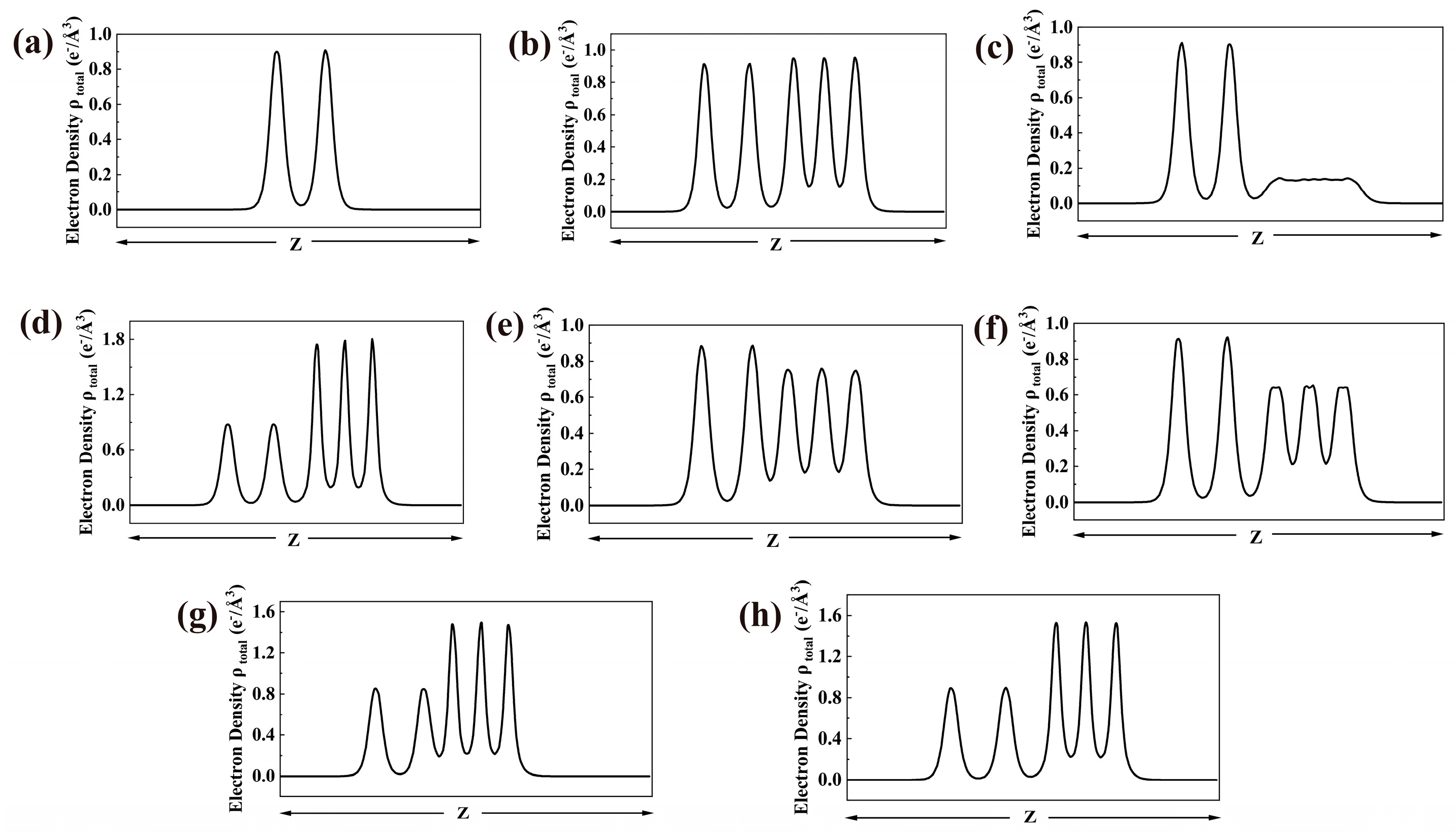
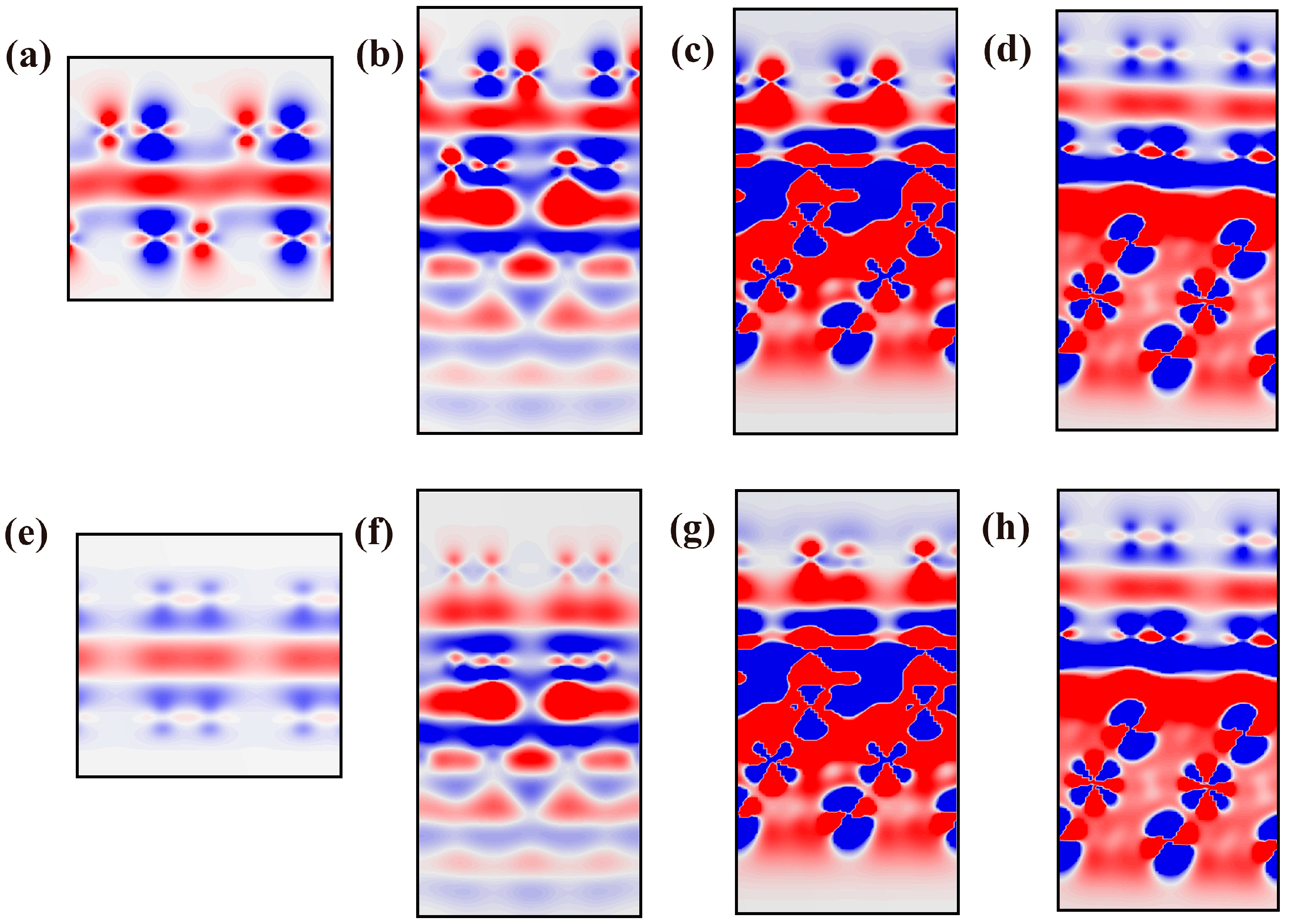
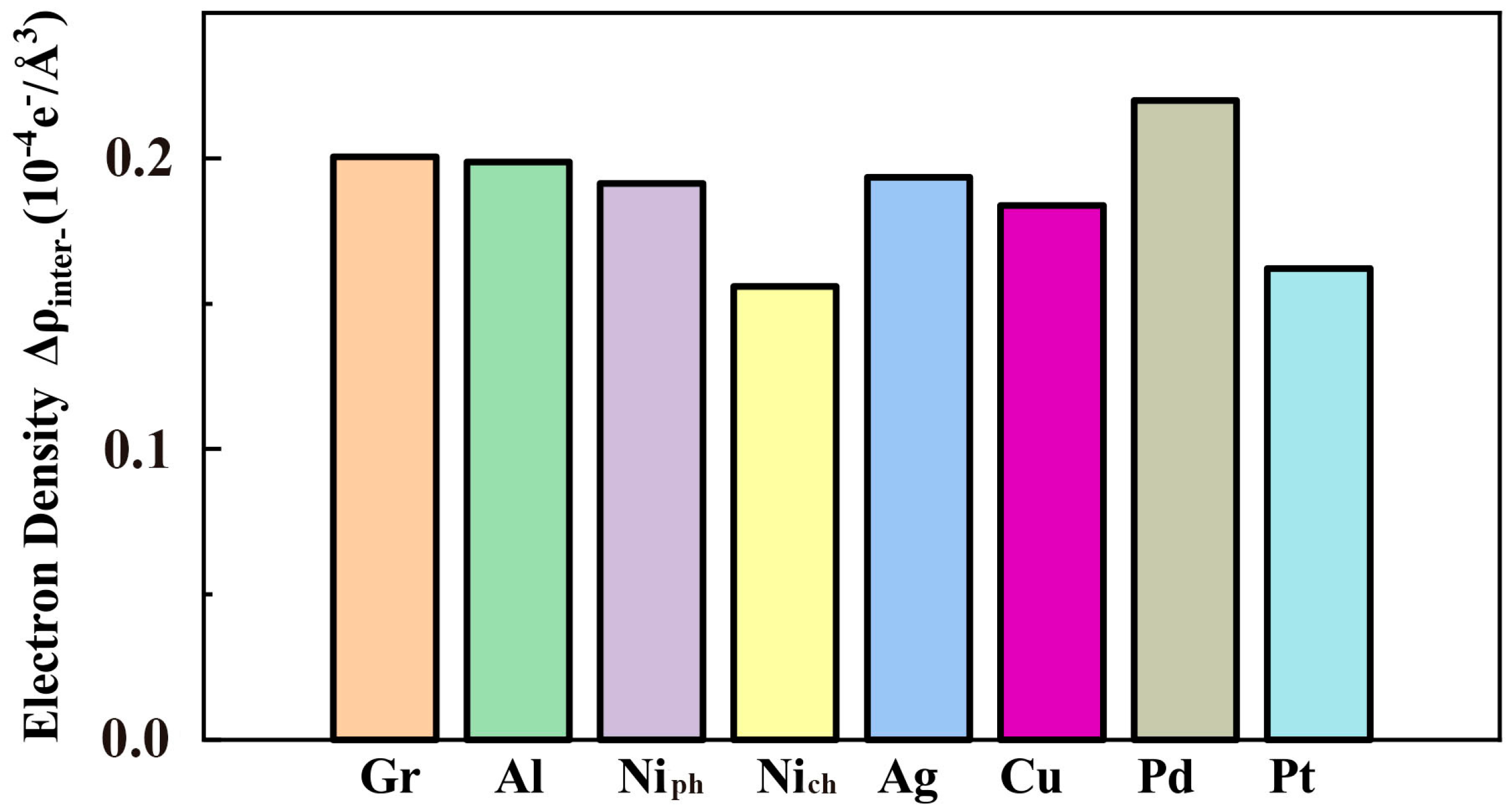
References
- Zhu, J.; Liu, X.; Shi, Q.; He, T.; Sun, Z.; Guo, X.; Liu, W.; Sulaiman, O.B.; Dong, B.; Lee, C. Development trends and perspectives of future sensors and MEMS/NEMS. Micromachines 2019, 11, 7. [Google Scholar] [CrossRef]
- Kim, S.H.; Asay, D.B.; Dugger, M.T. Nanotribology and MEMS. Nano Today 2007, 2, 22–29. [Google Scholar] [CrossRef]
- Feng, B.; Sugino, O.; Liu, R.-Y.; Zhang, J.; Yukawa, R.; Kawamura, M.; Iimori, T.; Kim, H.; Hasegawa, Y.; Li, H. Dirac fermions in borophene. Phys. Rev. Lett. 2017, 118, 096401. [Google Scholar] [CrossRef] [PubMed]
- Spear, J.C.; Ewers, B.W.; Batteas, J.D. 2D-nanomaterials for controlling friction and wear at interfaces. Nano Today 2015, 10, 301–314. [Google Scholar] [CrossRef]
- Dietzel, D.; Brndiar, J.; Stich, I.; Schirmeisen, A. Limitations of structural superlubricity: Chemical bonds versus contact size. ACS Nano 2017, 11, 7642–7647. [Google Scholar] [CrossRef] [PubMed]
- Liu, P.; Xie, J.; Wang, A.; Ma, D.; Mao, Z. First-principles prediction of enhancing graphene/Al interface bonding strength by graphene doping strategy. Appl. Surf. Sci. 2020, 517, 146040. [Google Scholar] [CrossRef]
- Zhang, J.; Gao, X.; Xu, Q.; Ma, T.; Hu, Y.; Luo, J. Atomistic insights into friction and wear mechanisms of graphene oxide. Appl. Surf. Sci. 2021, 546, 149130. [Google Scholar] [CrossRef]
- Wang, L.; Zhou, X.; Ma, T.; Liu, D.; Gao, L.; Li, X.; Zhang, J.; Hu, Y.; Wang, H.; Dai, Y. Superlubricity of a graphene/MoS 2 heterostructure: A combined experimental and DFT study. Nanoscale 2017, 9, 10846–10853. [Google Scholar] [CrossRef]
- Song, Y.; Mandelli, D.; Hod, O.; Urbakh, M.; Ma, M.; Zheng, Q. Robust microscale superlubricity in graphite/hexagonal boron nitride layered heterojunctions. Nat. Mater. 2018, 17, 894–899. [Google Scholar] [CrossRef]
- Zhang, Z.; Yang, Y.; Gao, G.; Yakobson, B.I. Two-dimensional boron monolayers mediated by metal substrates. Angew. Chem. 2015, 127, 13214–13218. [Google Scholar] [CrossRef]
- Khomyakov, P.; Giovannetti, G.; Rusu, P.; Brocks, G.v.; Van den Brink, J.; Kelly, P.J. First-principles study of the interaction and charge transfer between graphene and metals. Phys. Rev. B 2009, 79, 195425. [Google Scholar] [CrossRef]
- Lee, C.; Li, Q.; Kalb, W.; Liu, X.-Z.; Berger, H.; Carpick, R.W.; Hone, J. Frictional characteristics of atomically thin sheets. Science 2010, 328, 76–80. [Google Scholar] [CrossRef] [PubMed]
- Zheng, X.; Gao, L.; Yao, Q.; Li, Q.; Zhang, M.; Xie, X.; Qiao, S.; Wang, G.; Ma, T.; Di, Z. Robust ultra-low-friction state of graphene via moiré superlattice confinement. Nat. Commun. 2016, 7, 13204. [Google Scholar] [CrossRef]
- Jiang, J.-W.; Wang, J.-S.; Li, B. Young’s modulus of graphene: A molecular dynamics study. Phys. Rev. B 2009, 80, 113405. [Google Scholar] [CrossRef]
- Ji, E.; Kim, M.J.; Lee, J.-Y.; Sung, D.; Kim, N.; Park, J.-W.; Hong, S.; Lee, G.-H. Substrate effect on doping and degradation of graphene. Carbon 2021, 184, 651–658. [Google Scholar] [CrossRef]
- Peng, B.; Zhang, H.; Shao, H.; Xu, Y.; Zhang, R.; Zhu, H. The electronic, optical, and thermodynamic properties of borophene from first-principles calculations. J. Mater. Chem. C 2016, 4, 3592–3598. [Google Scholar] [CrossRef]
- Munther, M.; Palma, T.; Beheshti, A.; Davami, K. Substrate-regulated nanoscale friction of graphene. Mater. Lett. 2018, 221, 54–56. [Google Scholar] [CrossRef]
- Qi, Y.; Liu, J.; Dong, Y.; Feng, X.-Q.; Li, Q. Impacts of environments on nanoscale wear behavior of graphene: Edge passivation vs. substrate pinning. Carbon 2018, 139, 59–66. [Google Scholar] [CrossRef]
- Zeng, X.; Peng, Y.; Lang, H. A novel approach to decrease friction of graphene. Carbon 2017, 118, 233–240. [Google Scholar] [CrossRef]
- Shi, B.; Gan, X.; Lang, H.; Zou, K.; Wang, L.; Sun, J.; Lu, Y.; Peng, Y. Ultra-low friction and patterning on atomically thin MoS2 via electronic tight-binding. Nanoscale 2021, 13, 16860–16871. [Google Scholar] [CrossRef]
- Rajesh, C.; Majumder, C. Interaction of gold clusters with graphene and graphene layer over Ni(111) surface: A density functional study. Appl. Surf. Sci. 2019, 469, 917–922. [Google Scholar] [CrossRef]
- Lu, Y.; Xiao, C.; Jiang, Y.; Tang, C.; Chen, L.; Sun, J.; Qian, L. Nanoscale Wear Triggered by Stress-Driven Electron Transfer. Nano Lett. 2023, 23, 8842–8849. [Google Scholar] [CrossRef] [PubMed]
- Tang, C.; Jiang, Y.; Chen, L.; Sun, J.; Liu, Y.; Shi, P.; Aguilar-Hurtado, J.Y.; Rosenkranz, A.; Qian, L. Layer-Dependent Nanowear of Graphene Oxide. ACS Nano 2023, 17, 2497–2505. [Google Scholar] [CrossRef] [PubMed]
- Sun, J.; Chang, K.; Mei, D.; Lu, Z.; Pu, J.; Xue, Q.; Huang, Q.; Wang, L.; Du, S. Mutual identification between the pressure-induced superlubricity and the image contrast inversion of carbon nanostructures from AFM technology. J. Phys. Chem. Lett. 2019, 10, 1498–1504. [Google Scholar] [CrossRef]
- Schneiderbauer, M.; Emmrich, M.; Weymouth, A.J.; Giessibl, F.J. CO tip functionalization inverts atomic force microscopy contrast via short-range electrostatic forces. Phys. Rev. Lett. 2014, 112, 166102. [Google Scholar] [CrossRef]
- Lee, A.J.; Sakai, Y.; Chelikowsky, J.R. Simulating contrast inversion in atomic force microscopy imaging with real-space pseudopotentials. Phys. Rev. B 2017, 95, 081401. [Google Scholar] [CrossRef]
- Segall, M.; Lindan, P.J.; Probert, M.a.; Pickard, C.J.; Hasnip, P.J.; Clark, S.; Payne, M. First-principles simulation: Ideas, illustrations and the CASTEP code. J. Phys. Condens. Matter 2002, 14, 2717. [Google Scholar] [CrossRef]
- Clark, S.J.; Segall, M.D.; Pickard, C.J.; Hasnip, P.J.; Probert, M.I.; Refson, K.; Payne, M.C. First principles methods using CASTEP. Z. Krist.-Cryst. Mater. 2005, 220, 567–570. [Google Scholar] [CrossRef]
- Vanin, M.; Mortensen, J.J.; Kelkkanen, A.; Garcia-Lastra, J.M.; Thygesen, K.S.; Jacobsen, K.W. Graphene on metals: A van der Waals density functional study. Phys. Rev. B 2010, 81, 081408. [Google Scholar] [CrossRef]
- Fuentes-Cabrera, M.; Baskes, M.I.; Melechko, A.V.; Simpson, M.L. Bridge structure for the graphene/Ni (111) system: A first principles study. Phys. Rev. B 2008, 77, 035405. [Google Scholar] [CrossRef]
- Bhushan, B. Nanotribology and Nanomechanics: An Introduction; Springer: Berlin/Heidelberg, Germany, 2008. [Google Scholar]
- Paolicelli, G.; Tripathi, M.; Corradini, V.; Candini, A.; Valeri, S. Nanoscale frictional behavior of graphene on SiO2 and Ni(111) substrates. Nanotechnology 2015, 26, 055703. [Google Scholar] [CrossRef]
- Tripathi, M.; Awaja, F.; Paolicelli, G.; Bartali, R.; Iacob, E.; Valeri, S.; Ryu, S.; Signetti, S.; Speranza, G.; Pugno, N.M. Tribological characteristics of few-layer graphene over Ni grain and interface boundaries. Nanoscale 2016, 8, 6646–6658. [Google Scholar] [CrossRef]
- Chen, J.; Li, J.; Xiong, D.; He, Y.; Ji, Y.; Qin, Y. Preparation and tribological behavior of Ni-graphene composite coating under room temperature. Appl. Surf. Sci. 2016, 361, 49–56. [Google Scholar] [CrossRef]
- Liu, Y.; Zheng, F.; Wu, Y.; Koch, C.C.; Han, P.; Zhang, C.; Liu, Y.; Zhang, Y. Grain refinement induced friction reduction and anti-wear performances of electrodeposited graphene/Ni composites with low content reduced graphene oxide. J. Alloys Compd. 2020, 826, 154080. [Google Scholar] [CrossRef]
- Dong, Y.r.; Sun, W.c.; Liu, X.j.; Ma, M.; Zhang, Y.g.; Liu, Y.w. Electrophoretic-Deposition of Graphene and Microstructure and Friction Behavior of Ni–Graphene Composite Coatings. Adv. Eng. Mater. 2019, 21, 1900327. [Google Scholar] [CrossRef]
- Sun, J.; Zhang, Y.; Lu, Z.; Li, Q.; Xue, Q.; Du, S.; Pu, J.; Wang, L. Superlubricity enabled by pressure-induced friction collapse. J. Phys. Chem. Lett. 2018, 9, 2554–2559. [Google Scholar] [CrossRef] [PubMed]
- Gao, J.; Luedtke, W.; Gourdon, D.; Ruths, M.; Israelachvili, J.; Landman, U. Frictional Forces and Amontons’ Law: From the Molecular to the Macroscopic Scale. J. Phys. Chem. B 2004, 108, 3410–3425. [Google Scholar] [CrossRef]
- Cai, W.; Trefs, J.L.; Hugel, T.; Balzer, B.N. Anisotropy of π–π Stacking as Basis for Superlubricity. ACS Mater. Lett. 2022, 5, 172–179. [Google Scholar] [CrossRef]
- Liu, Y.; Jiang, Y.; Sun, J.; Wang, L.; Liu, Y.; Chen, L.; Zhang, B.; Qian, L. Durable superlubricity of hydrogenated diamond-like carbon film against different friction pairs depending on their interfacial interaction. Appl. Surf. Sci. 2021, 560, 150023. [Google Scholar] [CrossRef]
- Zhao, S.; Zhang, Z.; Wu, Z.; Liu, K.; Zheng, Q.; Ma, M. The impacts of adhesion on the wear property of graphene. Adv. Mater. Interfaces 2019, 6, 1900721. [Google Scholar] [CrossRef]
- Giovannetti, G.; Khomyakov, P.A.; Brocks, G.; Karpan, V.M.; van den Brink, J.; Kelly, P.J. Doping graphene with metal contacts. Phys. Rev. Lett. 2008, 101, 026803. [Google Scholar] [CrossRef] [PubMed]
- Hamada, I.; Otani, M. Comparative van der Waals density-functional study of graphene on metal surfaces. Phys. Rev. B 2010, 82, 153412. [Google Scholar] [CrossRef]
- Cheng, Z.; Sun, J.; Zhang, B.; Lu, Z.; Ma, F.; Zhang, G.; Xue, Q. Strain effects of vertical separation and horizontal sliding in commensurate two-dimensional homojunctions. J. Phys. Chem. Lett. 2020, 11, 5815–5822. [Google Scholar] [CrossRef] [PubMed]
- Wolloch, M.; Levita, G.; Restuccia, P.; Righi, M. Interfacial charge density and its connection to adhesion and frictional forces. Phys. Rev. Lett. 2018, 121, 026804. [Google Scholar] [CrossRef] [PubMed]
- Zhang, B.; Zhang, G.; Cheng, Z.; Ma, F.; Lu, Z. Atomic-scale friction adjustment enabled by doping-induced modification in graphene nanosheet. Appl. Surf. Sci. 2019, 483, 742–749. [Google Scholar] [CrossRef]
- Zhong, W.; Tomanek, D. First-principles theory of atomic-scale friction. Phys. Rev. Lett. 1990, 64, 3054. [Google Scholar] [CrossRef] [PubMed]

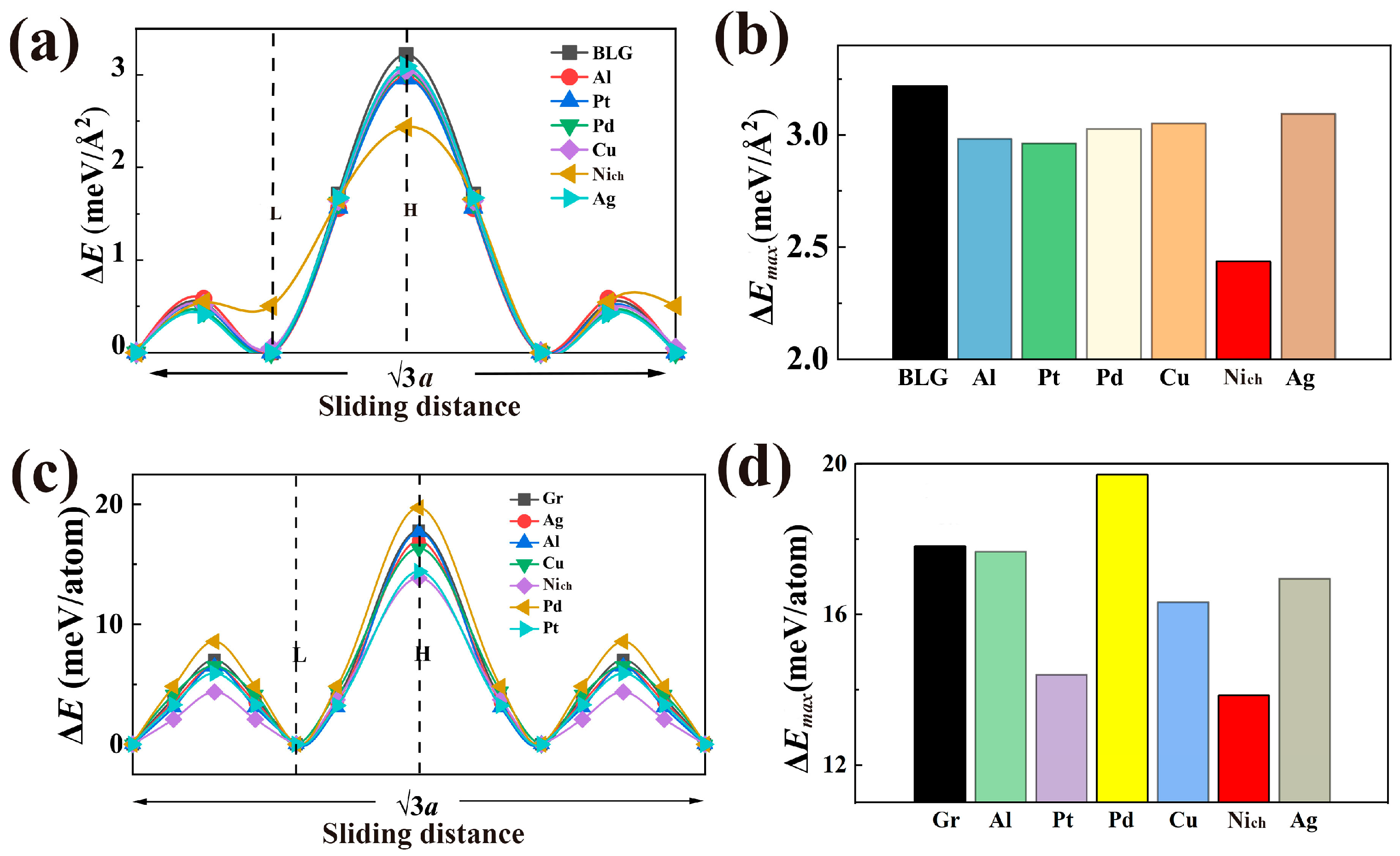
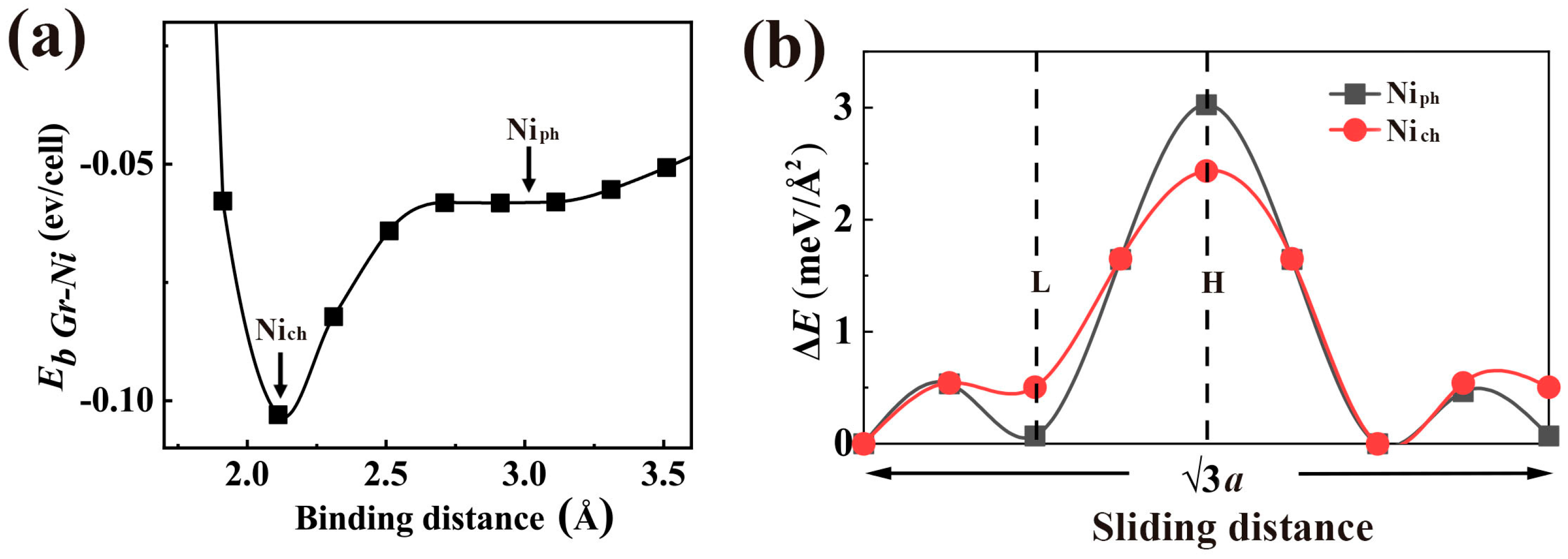
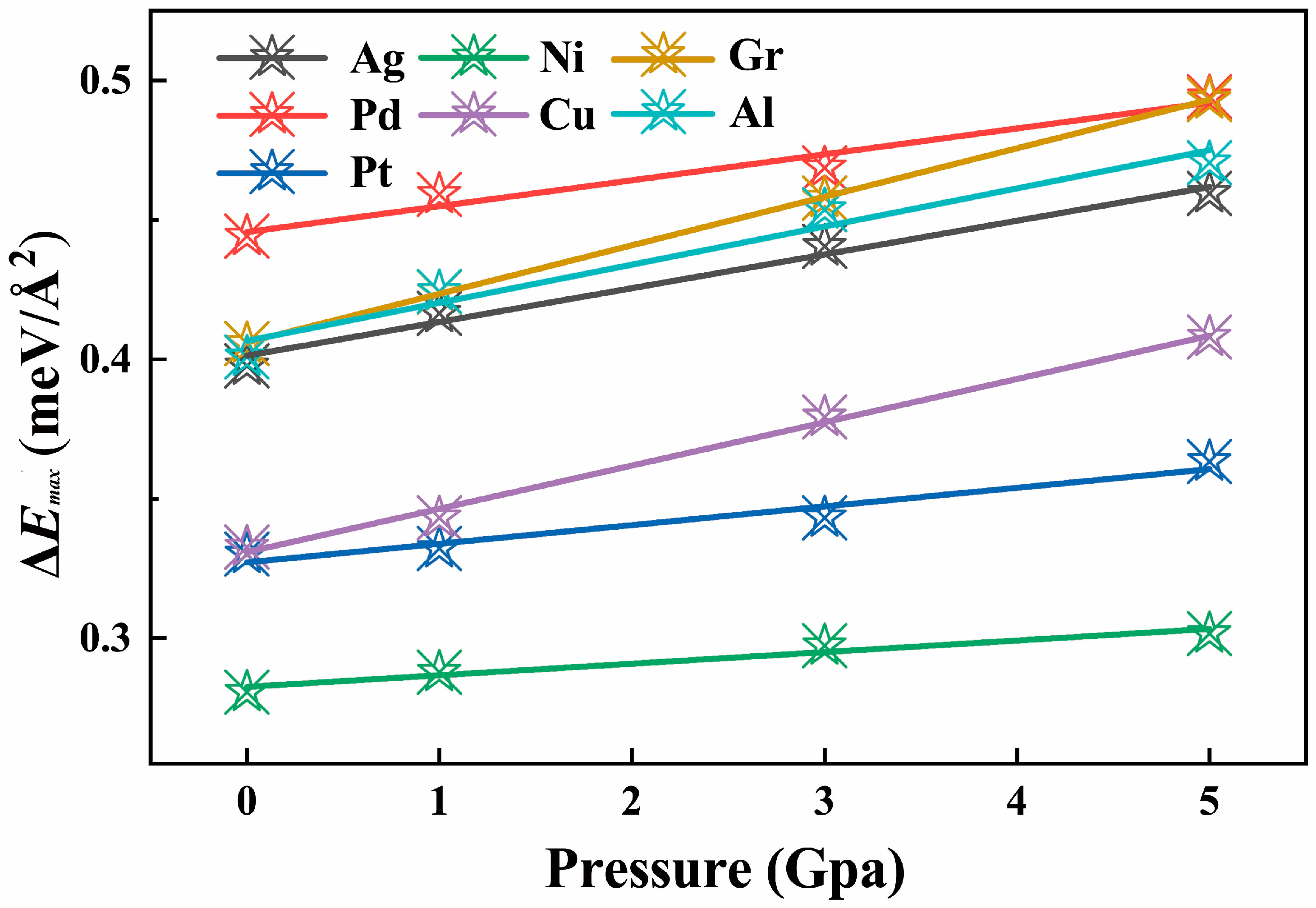
| Gr-Gr/Metal | (meV/Å2) | (Å) |
|---|---|---|
| Without substrate | 0.0251 | 3.325 |
| Ag | 0.0239 | 3.338 |
| Al | 0.0249 | 3.303 |
| Cu | 0.0236 | 3.324 |
| Ni | 0.0616 | 3.324 |
| Pd | 0.0266 | 3.273 |
| Pt | 0.0251 | 3.308 |
| Tip-Gr/Metal | (eV/Å2) | (Å) |
| Without substrate | 0.2192 | 1.968 |
| Ag | 0.2322 | 1.972 |
| Al | 0.2142 | 1.978 |
| Cu | 0.2310 | 1.972 |
| Ni | 0.2016 | 2.011 |
| Pd | 0.2188 | 2.035 |
| Pt | 0.2373 | 2.001 |
Disclaimer/Publisher’s Note: The statements, opinions and data contained in all publications are solely those of the individual author(s) and contributor(s) and not of MDPI and/or the editor(s). MDPI and/or the editor(s) disclaim responsibility for any injury to people or property resulting from any ideas, methods, instructions or products referred to in the content. |
© 2023 by the authors. Licensee MDPI, Basel, Switzerland. This article is an open access article distributed under the terms and conditions of the Creative Commons Attribution (CC BY) license (https://creativecommons.org/licenses/by/4.0/).
Share and Cite
Feng, H.; Cheng, Z.; Long, D.; Yang, T.; Lu, Z.; He, Q. How Do Substrates Affect the Friction on Graphene at the Nanoscale? Lubricants 2023, 11, 465. https://doi.org/10.3390/lubricants11110465
Feng H, Cheng Z, Long D, Yang T, Lu Z, He Q. How Do Substrates Affect the Friction on Graphene at the Nanoscale? Lubricants. 2023; 11(11):465. https://doi.org/10.3390/lubricants11110465
Chicago/Turabian StyleFeng, Haochen, Ziwen Cheng, Dongxu Long, Tingting Yang, Zhibin Lu, and Qichang He. 2023. "How Do Substrates Affect the Friction on Graphene at the Nanoscale?" Lubricants 11, no. 11: 465. https://doi.org/10.3390/lubricants11110465





